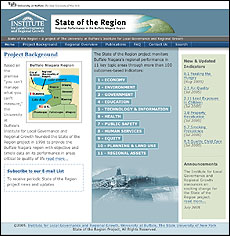Archives
UB institute launches new "State of the Region" Web site
By RACHEL M. TEAMAN
Reporter Contributor
The Institute for Local Governance and Regional Growth has launched a new Web site for its "State of the Region" project at http://www.regional-institute.buffalo.edu/sotr that will incorporate updates on the project's performance indicators and data as they become available.

Guided by the motto, "you can't manage what you can't measure," the "State of the Region," founded by the institute in 1998, monitors the Buffalo-Niagara region's performance in key areas through more than 100 outcomes-based indicators across 11 major topic areas.
The Web site features a more dynamic format, enhanced tools for accessing and sorting data, and user-friendly navigation options, including the organization of data by topic areas (economy, environment, government, education, technology and information, health, public safety, human services, equity, planning and land use, and regional assets).
"The 'State of the Region' project has always been about providing Buffalo Niagara with critical, reliable data on important regional issues, and doing so in a timely manner. The new and enhanced Web site simply meets this goal more effectively, more efficiently and more often," said institute Director John B. Sheffer II, who will step down as director on Sept. 1.
One key advantage of the new format is the release of the project's performance indicators and data as they are available. Prior to this transition, the project was based on a periodic report schedule, with three reports released since 1999, including the baseline report and progress reports in 2000 and 2002.
"An enhanced online presence is a natural progression for the project," added Kathryn A. Foster, associate professor of urban and regional planning in the School of Architecture and Planning. "The new format taps the flexibility and real-time nature of the Web to better track regional performance." Foster, who will assume the position of institute director on Sept. 1, oversaw the project as the institute's director of research from 1999 to 2002.
The institute began expanding the project's Web presence in February by posting 22 indicator updates online. Along with the unveiling of the new Web site, the "State of the Region" is releasing five additional indicator updates across four topic areas:
Environment—2.1 Air Quality. Ozone levels in the region are slightly higher than the new, more stringent national standard; Western New York's air particulate pollution declined and remains below statewide and national averages.
Environment—2.11 Lead Exposure in Children. Lead screening of children under the age of 2 has not changed materially; all Western New York counties registered decreases in the proportion of children with elevated lead levels and lead poisoning.
Government—3.8 Property Revaluation. Nearly two-thirds of Western New York municipalities completed reassessment projects within the past three years; roughly half of all cities conducted reassessments in 2005.
Health—6.7 Smoking Prevalence. The percentage of adult smokers in Western New York dropped slightly, but remains higher than statewide and national rates; counter to national trends, tobacco use among Erie County ninth graders dropped and is below the national rate.
Human Services—8.3 Quality Child Care. Western New York registered modest gains in its number of licensed or registered child care providers and accredited child care programs; the region still faces shortage of quality facilities and programs.
The public is encouraged to check back at the site periodically for project news and updated performance indicators, as well as links to related research and reports.
